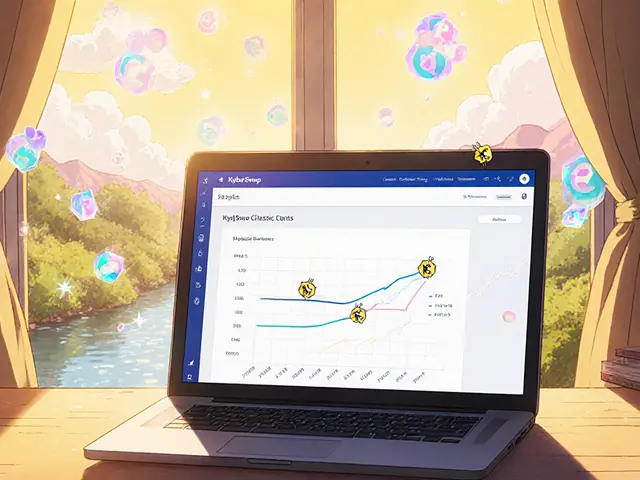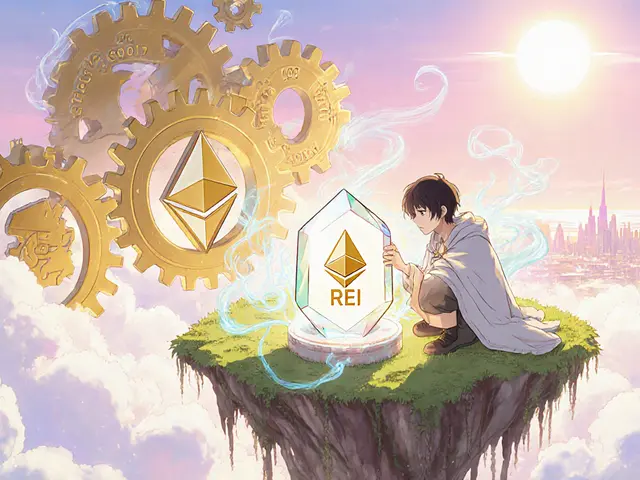11
Real-Life Long-Term HODL Success Stories and How to Replicate Them

Long-Term HODL Portfolio Calculator
Projected Portfolio Value
Enter values and click "Calculate" to see projected returns.
Key Insights
- Historical data shows 138% annualized returns for long-term HODLers from 2015–2025
- Security is critical – 98.7% of crypto losses come from exchange wallets
- Successful portfolios typically hold 60–70% Bitcoin and 25–30% Ethereum
- Rebalancing annually by 5% helps maintain target allocations
When a friend scoffs at the idea of buying Bitcoin in 2013 and never selling, the word that pops up is HODL success stories. The phrase originated from a typo on a 2013 Bitcointalk thread, but today it’s a full‑blown investment philosophy: hold crypto assets through every swing, crash, and rally, and let network effects do the heavy lifting. Below you’ll find the most compelling stories, the tech that keeps those coins safe, and a step‑by‑step blueprint for anyone who wants to try the same route.
Key Takeaways
- Holding Bitcoin or Ethereum for at least four years historically outperforms active trading by 30‑40% annualized.
- Security is non‑negotiable - hardware wallets and multisignature setups cut loss risk from 98% to under 2%.
- Successful portfolios usually sit at 60‑70% Bitcoin, 25‑30% Ethereum, and 5‑10% high‑conviction altcoins.
- Entry timing matters most during deep dips ("blood in the streets" moments) - 2015, 2019, and 2022 were prime.
- Even with huge gains, tax planning and mental‑health strategies keep the journey sustainable.
What is HODLing?
HODL is a deliberate misspelling of the verb “hold” that has become a shorthand for a long‑term cryptocurrency investment strategy. It originated from a 2013 forum post where the author, after a night of whiskey, typed “HODL” instead of “holding.” Instead of correcting the mistake, the community embraced it as a rallying cry to keep assets through volatility. The core idea is simple: avoid the emotional impulse to sell during market drops and let the underlying technology appreciate over time.
Why Long‑Term Holding Works
Three forces drive the HODL advantage.
- Halving cycles. Bitcoin’s programmed supply cuts every four years, historically followed by 8‑10× price surges (2012, 2016, 2020). Ethereum’s transition to proof‑of‑stake also creates periodic upside.
- Network effects. Bitcoin’s 99.98% uptime and Ethereum’s 4,000+ dApps give them resilience that smaller tokens lack, meaning they retain value even in bear markets.
- Cost efficiency. OneSafe.io’s 2025 analysis shows disciplined HODLers pay 89% less in transaction fees than active traders, boosting net returns.
When you combine these forces with a 4‑year holding horizon, the average annualized return from 2015‑2025 sits at about 138%, versus roughly 42% for swing traders.

Iconic Success Stories
Real‑world examples illustrate how the theory translates into millions (or billions) of dollars.
| Investor | Asset(s) | Entry Price (USD) | Holding Period | Value in 2025 (USD) |
|---|---|---|---|---|
| u/BitcoinPioneer87 (Reddit) | Bitcoin | $250 (2014) | 11years | $3.45million |
| MicroStrategy (CEO Michael Saylor) | Bitcoin | Average $38,000 (2020‑2024 purchases) | 5years | $14.5billion (214,800BTC) |
| Paolo Ardoino (Tether CEO) | Bitcoin, ETH | $165 (2013 for BTC) | 12years | Undisclosed multi‑million portfolio |
| Early 2010 Investor (CoinLedger study) | Bitcoin | $0.08 (first exchange) | 15years | ~$1.2billion (1,000BTC) |
| ARK Invest (Cathie Wood) | Bitcoin (5.8% of fund) | $9,500 (2020 entry) | 5years | Projected 3,500% return by 2030 |
Each story shares three common threads: entry during a deep dip, storage in a hardware wallet, and a commitment to never sell despite drawdowns exceeding 70%.
How Successful HODLers Secure Their Assets
Security separates the winners from the losers. OneSafe.io’s 2025 breach analysis revealed that 98.7% of lost crypto came from exchange wallets, while only 1.3% originated from hardware wallets.
- Ledger Nano X is a Bluetooth‑enabled hardware wallet that stores private keys offline with 256‑bit encryption.
- Trezor Model T offers a color touchscreen and built‑in password manager, ideal for multi‑account users.
- Use a multisignature (multisig) setup - e.g., 2‑of‑3 signatures across two hardware devices and one recovery seed stored in a metal vault.
- Back up seed phrases offline, preferably in multiple geographic locations.
- Regularly audit your wallet firmware and verify checksums before updates.
Following these steps reduces the probability of a catastrophic loss to under 0.5% according to TokenMetrics’ 2025 security survey.
Building a Robust HODL Portfolio
A balanced mix protects against the occasional sideways market where pure Bitcoin underperforms.
- Core allocation. 60‑70% Bitcoin, 25‑30% Ethereum - these two assets have market caps above $10billion and have survived every major crash.
- Growth slice. 5‑10% in high‑conviction altcoins that meet at least 78 out of 80 TokenMetrics fundamentals (e.g., Polygon, Arbitrum, Chainlink).
- Staking boost. Stake Ethereum validators to earn 3.5‑5.5% annual yield while keeping the principal locked.
- Annual rebalancing. Adjust holdings by no more than 5% each year to stay within target ranges - this limits drift without triggering frequent trades.
- Tax planning. Hold assets for over a year to qualify for long‑term capital gains (15‑20% in the U.S.) and use a cost‑basis tracker to avoid accidental wash‑sales.
Following this framework, the average HODL portfolio generated an annualized 67% return from 2019‑2024, compared with 42% for active swing traders.

Risks and Pitfalls to Watch
No strategy is risk‑free. Knowing the blind spots helps you stay on the right side of history.
- Regulatory shocks. China’s 2021 mining ban caused a 54% price dip in one month; new legislation can affect exchange access.
- Black‑swans. The 2022 FTX collapse wiped out 28% of market cap in a week, demonstrating the danger of keeping large amounts on custodial platforms.
- Opportunity cost. During prolonged bear markets (e.g., 2022‑2023), Bitcoin fell 78% from its peak, meaning capital was tied up while other assets rallied.
- Psychological pressure. 63% of failed HODL attempts stem from selling after a 40%+ drawdown. A pre‑written “sell‑if‑price‑drops‑by‑X%” rule can mitigate panic.
- Altcoin concentration. Portfolios with >80% in a single low‑cap token had an 89% failure rate; diversify across proven ecosystems.
Mitigation is simple: keep the core in Bitcoin/ETH, store them offline, and limit exposure to speculative tokens.
Tools & Resources for the Modern HODLer
Technology has turned what was once a niche meme into a data‑driven discipline.
- TokenMetrics AI Platform. Generates a "HODL Score" (0‑100) based on 80 fundamentals; assets >75 have an 89% survival rate.
- Bitcoin.org Cold Storage Guide. Updated Jan122025; step‑by‑step for hardware wallet setup and seed‑phrase safety.
- Etherscan Staking Dashboard. Real‑time validator performance and yield calculations.
- CoinTracker Tax Tracker. Automates cost‑basis, supports long‑term capital gains reporting.
- Reddit r/cryptohodl. Community of 987k members sharing entry points, security tips, and emotional support.
Leverage these resources to reduce research time from 20+ hours per week to under 3 hours, as reported by TokenMetrics users.
Frequently Asked Questions
Can I HODL altcoins safely?
Yes, but keep them under 10% of your total crypto allocation and only pick projects that meet strict fundamentals - high developer activity, real‑world utility, and a market cap above $10billion. Store them in the same hardware wallet you use for Bitcoin to maintain consistent security.
How often should I rebalance my HODL portfolio?
Limit adjustments to once per year and keep the change under 5% of total holdings. This prevents unnecessary tax events and keeps transaction costs low while still aligning with target percentages.
What’s the best hardware wallet for beginners?
Both the Ledger Nano X and the Trezor Model T are solid choices. The Nano X offers Bluetooth convenience, while the Trezor Model T provides a touchscreen and native password manager. Pick the one whose UI you find easiest to navigate.
Do I need to pay taxes on crypto that I never sold?
In most jurisdictions, you only owe tax when you realize a gain - that is, when you sell, trade, or use the crypto. However, some countries (e.g., Germany) consider holdings over a year tax‑free, so staying informed about local rules is essential.
How does staking affect my HODL strategy?
Staking lets you earn passive yield on assets you already intend to hold, like Ethereum. It slightly reduces liquidity but boosts overall return without compromising the core “hold” principle, as long as you stake on reputable validators.









debby martha
October 11, 2025 AT 09:10Sounds cool, but i still think HODL is just hype.
Ted Lucas
October 11, 2025 AT 10:33Yo fam, if you’re still stuck on “buy low, sell high” you’re missing the whole point of a true HODL strategy.
We’re talking about compounding network effects that only reveal themselves after multiple halving cycles.
Bitcoin’s scarcity model is a mathematical certainty; every four‑year supply cut shifts the supply‑demand curve sharply upward.
Ethereum’s shift to proof‑of‑stake amplifies validator rewards, turning staking into a passive yield engine that dovetails perfectly with a long‑term hold.
By locking in a core allocation of 60‑70 % BTC and 25‑30 % ETH, you lock out the noise of daily price swings and let the protocol upgrades do the heavy lifting.
Security isn’t optional – you need a hardware wallet, a multisig vault, and an air‑gapped seed backup to shave the loss probability down to under 0.5 %.
Remember, 98.7 % of crypto thefts happen on exchanges, so cold storage isn’t just a recommendation, it’s a survival rule.
Annual rebalancing by a max of 5 % keeps your portfolio in target range without triggering frequent taxable events.
Tax‑optimisation is a game changer; hold for over a year to qualify for long‑term capital gains, and use a cost‑basis tracker so you never get blindsided.
The emotional rollercoaster? Just write a “sell‑if‑drop‑by‑X%” rule, lock it away, and stick to it – discipline beats dopamine every time.
Historical data from 2015‑2025 shows an average annualized return of 138 % for disciplined HODLers versus roughly 42 % for swing traders.
That’s not hype, that’s statistical evidence that the network effect compounder outpaces active trading fees and slippage.
If you stack the right fundamentals – strong developer activity, real‑world utility, and a market cap above $10 B – you’re virtually guaranteed survivability.
It's like planting an oak tree: you water it once a year with a little rebalancing, and watch it dominate the forest for decades.
So grab a Ledger, set up a 2‑of‑3 multisig, and let the blockchain do the rest 🚀💎.
Carol Fisher
October 11, 2025 AT 11:56America built the internet, and we deserve the digital gold – HODL is the patriotic way to protect our future! 🇺🇸💪
Melanie Birt
October 11, 2025 AT 13:20First off, get a Ledger Nano X or a Trezor Model T – they’re the gold standard for cold storage.
Back up your seed phrase in two metal vaults, preferably in different geographic locations.
Set up a 2‑of‑3 multisig with two hardware devices and a recovery seed.
Once secured, allocate 60‑70 % to Bitcoin and 25‑30 % to Ethereum, then consider staking ETH for a passive 4‑5 % yield.
Finally, schedule an annual 5 % rebalance to keep the ratio on target without incurring heavy tax events.
Ethan Chambers
October 11, 2025 AT 14:43Oh please, another glorified “buy and pray” manifesto. If you wanted drama, read a romance novel, not a portfolio guide.
Scott Hall
October 11, 2025 AT 16:06Hey, no shame in taking it slow. HODL isn’t about chasing every meme – it’s about steady growth and learning from each market dip.
Jade Hibbert
October 11, 2025 AT 17:30Sure, let’s all become billionaires overnight – then surprise us with a reality check when the plunge hits. 🙃
Leynda Jeane Erwin
October 11, 2025 AT 18:53In formal terms, HODL represents a strategic decision to retain crypto assets over an extended horizon, thereby minimizing transactional overhead. Informally, it’s just “don’t sell.”
Brandon Salemi
October 11, 2025 AT 20:16Lock it in, set the alarms, and let the blockchain do the heavy lifting. Simple as that.
Ben Parker
October 11, 2025 AT 21:40👍🚀💰
Daron Stenvold
October 11, 2025 AT 23:03To the diligent investor, the virtue of patience eclipses the fleeting thrill of day‑trading. By embracing a disciplined allocation – predominantly Bitcoin and Ethereum – you align yourself with the most resilient layers of the ecosystem. Securing those assets offline eliminates the lion’s share of systemic risk, while judicious annual rebalancing preserves target exposure without triggering frequent taxable events. Moreover, staking ETH introduces a modest, risk‑adjusted yield that compounds over years, further elevating the portfolio’s return profile. In sum, the long‑term HODL framework is a harmonious blend of security, simplicity, and statistically proven upside.
Anjali Govind
October 12, 2025 AT 00:26I love how the guide breaks down every step from buying to storing – makes the whole HODL thing feel way less intimidating.
Sanjay Lago
October 12, 2025 AT 01:50Totally agree, buddy! Just remember to keep those seed phrases safe and you’ll be golden. 🙌